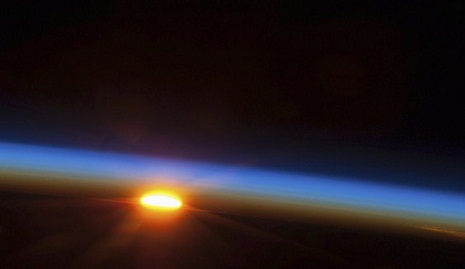How are space technologies changing life on Earth? - VIDEO

Click above to view the video, or read selected quotes below
On being a satellite
“I have had an extraordinary opportunity to actually be a satellite. These amazing views just dazzle you completely. This is the kind of thing you see once around the earth every 90 minutes – a sunrise and a sunset twice. Sixteen each in a 24 hour period. It’s quite a stunning experience.”
“Everything you probably heard other astronauts say is true. You don’t see the typical country borders, you get a very different sense of the scales of the planet, exclusive economic zones, territorial boundaries, the things that animate our news and awareness every day are not present. And a whole other dimension comes through.”
“But as the same time as this picture shows, you also clearly see the hand of man. And this is what we are the first generation of humans to do. Not only to be able to see the Earth from this perspective, but to develop technical means that let us to take very sophisticated snapshots essentially of the whole globe simultaneously, and develop the computational and scientific techniques that let us turn that into very powerful situational awareness about what’s happening, and what the state of the planet is at any given moment.”
On early use of data
“And even more importantly, to transform this data into foresight, into practical predictions about what conditions are likely to be sometime down the road. And that’s where we see really novel things happening in our era of society that get incorporated from mundane ones – “did you bring an extra hat or scarf today and did you realise it was going to snow?” – to decisions of much greater importance.”
“Weather has always been a factor in human affairs. These are two of the earliest weather satellites. The kind of imagery that they took was truly simple black and white, quite like your film camera. Just simple cloud images. If you live in California you’re dependent on weather systems that are coming in over the Pacific Ocean. If you live in Europe where you’ve got 3000 miles of ocean upstream of you, you’ve got the ability to see what cloud formations are over that ocean because they’re going to sort of stay intact and come your way three or five days later. That alone was pretty revolutionary weather reconnaissance in its day.”
On modern Satellites
“Satellites do things ranging from measure of cloud properties, to measurements that help us understand the water cycle, soil moisture, land cover, solar radiance – all sorts of different measurements we developed over these decades, specifically sensors that can provide the raw data that we can convert into those attributes. Satellites don’t measure those attributes directly, they measure radiance. And it is a body of scientific knowledge accumulated through a lot of research that lets us translate those radiances into these particular properties that are of interest to business planning or to agriculture.”
“You have in the upper left sea surface temperature. Again, how revolutionary was it to be able to see the whole globe almost simultaneously for sea surface temperature? It’s that data, the global view of that data in the 1970s that transformed our understanding of El Niño, from a local fisheries crisis that hit Peru occasionally to understanding that it’s a global oscillation in the Pacific Ocean. It’s one of the fundamental heartbeats of the planet. It affects the ocean and the atmosphere, and it drives about half of the weather variability of Europe or the central United States. Transformational understanding of what was going on there.”
Author: Kathryn Sullivan is the US Undersecretary of Commerce for Oceans and Atmosphere.















































